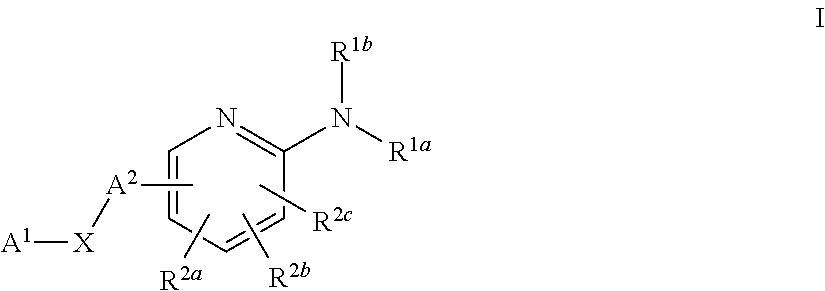Substituted Pyridines as Sodium Channel Blockers
a technology of sodium channel blocker and substituted pyridine, which is applied in the field of new substituted pyridine compounds, can solve the problems of many undesirable side effects of the currently available treatments
- Summary
- Abstract
- Description
- Claims
- Application Information
AI Technical Summary
Benefits of technology
Problems solved by technology
Method used
Image
Examples
example 1
Synthesis of (S)-2-acetamido-N-(6-(4-(4-fluorophenoxy)phenyl)pyridin-2-yl)-4-methylpentanamide
[0500]
Compound 2: 2-(4-(4-Fluorophenoxy)phenyl)-4,4,5,5-tetramethyl-1,3,2-dioxaborolane (compound 1; 368 mg, 1.4 mmol), 6-bromopyridin-2-amine (250 mg, 1.4 mmol) and sodium carbonate (1.2 g, 11.2 mmol) were dissolved in DMF / H2O (15 mL). Tetrakis(triphenylphosphine) palladium (81 mg, 0.07 mmol) was added thereto and the reaction mixture was refluxed for 4 h. The reaction mixture was cooled to room temperature and partitioned between EtOAc and water. The organic layer was separated and then dried over anhydrous Na2SO4. The solvent was evaporated and the oily residue was purified by column chromatography (silica gel, 30% EtOAc in hexane) to give 6-(4-(4-fluorophenoxy)phenyl)pyridin-2-amine as pale yellow oil (372 mg, 92%). Rf=0.6, eluent (1:1 EtOAc:hexanes), LC / MS: m / z=281 [M+H]+.
[0501]In an alternative procedure, to a solution of 6-bromopyridin-2-amine (4.329 g, 25.02 mmol, Aldrich) in dioxan...
example 2
Synthesis of (S)-2-acetamido-N-(6-(4-(4-fluorophenoxy)phenyl)pyridin-2-yl)-3-phenylpropanamide
[0503]
[0504]Compound 4: A mixture of AcN-(L)-Phe-OH (purchased from Sigma-Aldrich, 74.5 mg, 0.36 mmol), EDC (82 mg, 0.43 mmol), HOBt (58.0 mg, 0.43 mmol) in dry DCM was stirred for 1 h and compound 2 (100 mg, 0.36 mmol) was added thereto. The reaction mixture was stirred for 2 days at room temperature (67% conversion by LC / MS analysis) and it was quenched with saturated. NH4Cl. The aqueous layer was extracted with EtOAC and CHCl3. The combined organic layers were dried over anhydrous Na2SO4 and concentrated to give solid residue. The crude residue was purified by preparative TLC (1st purification: 50% EtOAc in hexanes; 2nd purification: 10% MeOH in DCM with 1% NH4OH) to give (S)-2-acetamido-N-(6-(4-(4-fluorophenoxy)phenyl)pyridin-2-yl)-3-phenylpropanamide (compound 4) as a white solid (26 mg, 15%). LC / MS: m / z=470 [M+H]+; 1H NMR (400 MHz, CDCl3): 8.46-8.45 (br, s, 1H), 8.08 (d, J=8.3 Hz, 1H)...
example 3
Synthesis of (S)—N-(1-((6-(4-(4-fluorophenoxy)phenyl)pyridin-2-yl)amino)-4-methyl-1-oxopentan-2-yl)picolinamide
[0505]
[0506]Compound 5: A mixture of Boc-Leu-OH (purchased from Sigma-Aldrich, 4.17 g, 18.0 mmol), EDC (4.1 g, 21.5 mmol), HOBt (2.9 g, 21.5 mmol) in dry DCM (300 mL) was stirred for 1 h at room temperature and compound 2 (5.0 g, 18.0 mmol) was added thereto. The reaction mixture was stirred for 12 h at room temperature. After the reaction was complete, it was quenched with saturated NH4Cl. The aqueous layer was extracted with EtOAc and CHCl3. The combined organic layers were dried over anhydrous Na2SO4 and concentrated to give oily residue which was then purified by column chromatography (silica gel, 30% EtOAc in hexane) to give compound 5 as pale yellow oil (4.0 g, 75% yield based on the recovered starting material (2.0 g)). LC / MS: m / z=496 [M+H]+; 1H NMR (400 MHz, CDCl3): 8.67 (br, s, 1H), 8.12 (d, J=8.33 Hz, 2H), 7.90 (d, J=8.99 Hz, 2H),), 7.76 (t, J=7.89 Hz, 1H), 7.42 (...
PUM
| Property | Measurement | Unit |
|---|---|---|
| temperatures | aaaaa | aaaaa |
| pH | aaaaa | aaaaa |
| pH | aaaaa | aaaaa |
Abstract
Description
Claims
Application Information
 Login to View More
Login to View More - R&D
- Intellectual Property
- Life Sciences
- Materials
- Tech Scout
- Unparalleled Data Quality
- Higher Quality Content
- 60% Fewer Hallucinations
Browse by: Latest US Patents, China's latest patents, Technical Efficacy Thesaurus, Application Domain, Technology Topic, Popular Technical Reports.
© 2025 PatSnap. All rights reserved.Legal|Privacy policy|Modern Slavery Act Transparency Statement|Sitemap|About US| Contact US: help@patsnap.com



